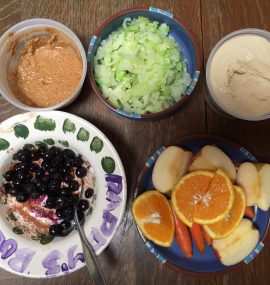People typically respond to calls to eat more fiber the way they respond to calls to exercise more: Yawn! But don't be short-sighted. Eating more fiber predicts a host of impressive benefits. The average American eats about 15 grams of fiber per day. That’s about half of the recommended minimum amount of about 30 grams per day. (The amount varies by age and sex). If a typical woman doubles her fiber intake, she’ll reduce her risk of obesity, type 2 diabetes, unhealthy blood fats, hypertension, non-alcoholic fatty liver disease, and cardiovascular disease. Quite a list!
What defines fiber, anyway? Fiber includes non-digestible carbohydrates and lignins that aren’t degraded in the upper gut. The viscous and gel-forming properties of soluble of dietary fiber reduce blood glucose increase after carbohydrate-rich meals. The insoluble fraction of dietary fiber (primarily from grains) predicts reduced risk of type 2 diabetes. Dietary fiber also improves insulin sensitivity, affects the composition of the microbiome, and improves inflammatory markers associated with the metabolic syndrome. Higher consumption of dietary fiber predicts lower body weight in a dose-dependent manner. High-fiber diets include intakes of at least 28 and 38 grams per day for women and men, respectively.
A recent meta-analysis reviewed 15 studies that evaluated the effectiveness of a high-fiber diet for controlling blood sugar in type 2 diabetic subjects. Overall, fiber supplementation lowered fasting blood glucose by a clinically significant 15.32 mg/dL and HbA1c by 0.3 percentage points. By way of comparison, if you blood glucose exceeds 100 mg/dL and HbA1c exceeds 6.5 percent, a doctor might diagnose you as diabetic. Incorporating more fiber in your diet can help control your blood sugar if you’re diabetic or not.
Can you feasibly double your intake of dietary fiber? Easy. Ramp up you consumption of fruits, vegetables, whole grains, and legumes (beans and their relatives). But modern hunter-gatherers eat far fiber more than that and don’t get cardiovascular diseases. But could modern Americans feasibly eat an extra-high fiber diet? Yes.
Researchers in Texas developed extra-high fiber experimental diets (50 grams of fiber per day, half soluble and half insoluble) with natural foods and no fiber supplements. Research subjects found the extra-high-fiber meals acceptable and complied with instructions to eat the prescribed meals. Compared to the diet recommended by the American Diabetes Association, the extra-high fiber diet led to significantly lower post-meal blood glucose and lowered daily blood glucose and insulin. The extra-high fiber diet also reduced concentrations of total cholesterol, LDL-cholesterol, and triglyceride. Researchers attributed the beneficial effects of the extra-high fiber diet mainly to increased soluble fiber.
Fiber isn’t sexy, but you can do yourself a world of good by eating more fiber. Find more fruits, vegetables, whole grains, and legumes that you like and eat more of them.








